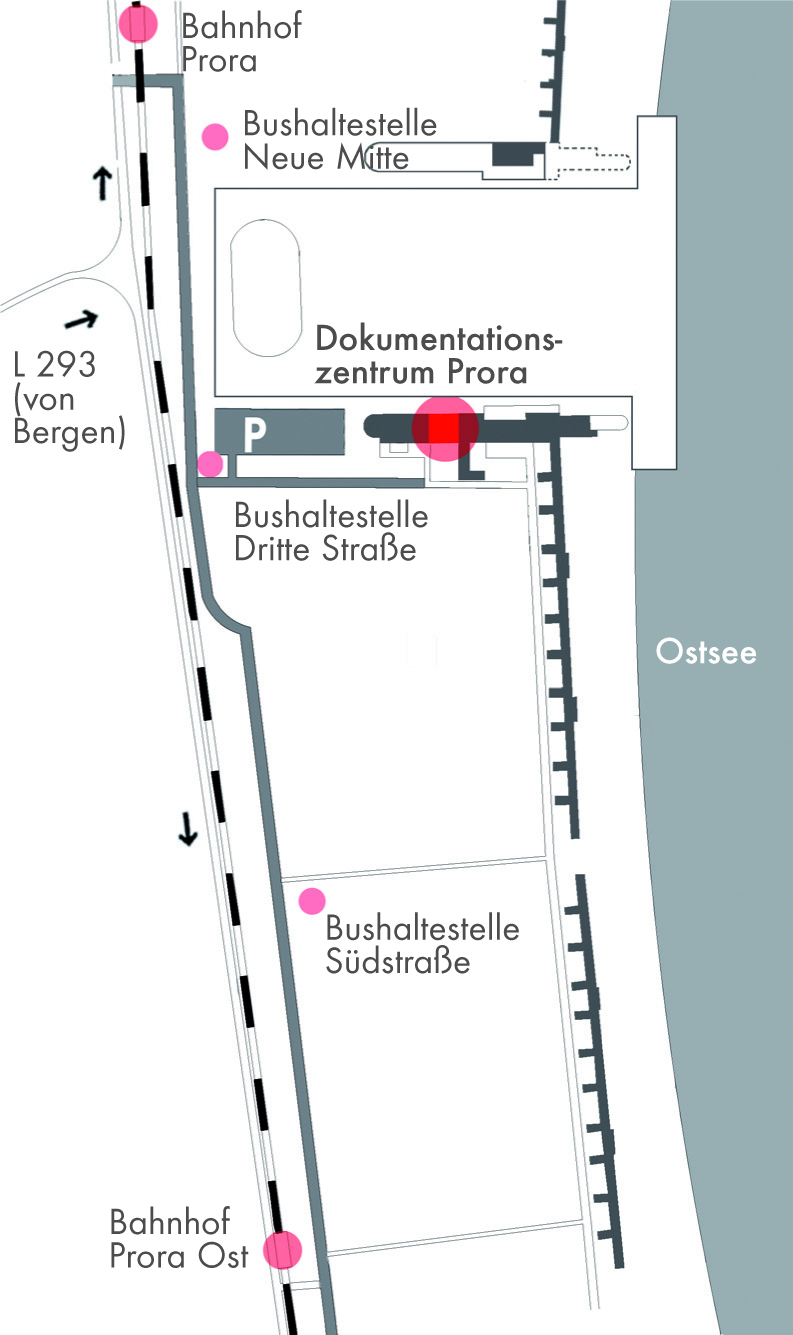Projekt Meja-Grenze
Meja – Grenze
Das Folgeprojekt „Meja- Grenze“ hat in der Reihe des Projektes „ طخ / دودحلا„ – Grenzlinie –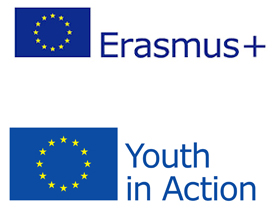 Border / Line– Meja /Linje“ im Frühjahr 2023 über eine Woche erfolgreich stattgefunden. Es wurde im Rahmen des „Erasmus+ /Youth in Action“-Programms gemeinsam mit unseren europäischen Partnern umgesetzt. Diesmal war der slowenische Partner, die Volksuniversität LUNG, der Koordinator und Organisator des Projektes und hat nach Nova Gorica/Gorizia eingeladen.
Border / Line– Meja /Linje“ im Frühjahr 2023 über eine Woche erfolgreich stattgefunden. Es wurde im Rahmen des „Erasmus+ /Youth in Action“-Programms gemeinsam mit unseren europäischen Partnern umgesetzt. Diesmal war der slowenische Partner, die Volksuniversität LUNG, der Koordinator und Organisator des Projektes und hat nach Nova Gorica/Gorizia eingeladen.
Unsere Partner:
- LUNG, Volksuniversität in Nova Gorica
- Associazione Culturale Quarantasettezeroquattro in Gorizia
- Istituto Salesiano Bearzi-Udine
- MS 5-Mittelschule für Klagenfurt am Wörthersee–Wölfnitz
- Regionale Schule Sassnitz
Ein besonderer Dank geht an Mojca (LUNG), die über eine Woche ein sehr interessantes Programm zusammengestellt hat, Suzana (Gymnasium Nova Gorica), Marko (Goriški Muzej) und Alex (Associazione Culturale Quarantasettezeroquattro).
Das Projekt:
Im Anschluss an das vorangegangene Projekt trafen sich diesmal junge Menschen aus Slowenien, Italien, Deutschland und Österreich, Jungen und Mädchen zwischen 13 und 20 Jahren.
Die Perspektive einer Teilung von Regionen und die Überwindung der Teilung sollte bei dem Projekt an den historischen Orten nachvollziehbar gemacht werden. Die Teilungen Jugoslawiens, die Situation während des Ersten Weltkriegs, während und nach dem Zweiten Weltkrieg, die Teilung der Stadt in ein slowenisches Nova Gorica und ein italienisches Gorizia 1947, die ganz unterschiedlichen Entwicklungen parallel zueinander von einem Zaun getrennt aber in Nachbarschaft und die Entwicklung nach der Öffnung mit dem Schengen- Abkommen 2007, seitdem die Grenze zwischen Slowenien und Italien überall problemlos überschritten werden kann. Alle sind Bürger eines Staates der Europäischen Union. Nationalismus und Vorurteile
sind auch heute noch Herausforderungen, die überwunden werden. Nova Gorica wird gemeinsam mit Gorizia 2025 und gleichzeitig mit Chemnitz Kulturhauptstadt Europas sein.
Die Jugendlichen sollten sich mit den verschiedenen Perspektiven verschiedener Bevölkerungsteile vor Ort bekannt machen als auch der verschiedenen Perspektiven der Projektteilnehmenden. Die Herausforderungen des Zusammenlebens heute konnten vor dem Hintergrund der Erfahrungen, die sie bereits in Berlin und Prora gemacht hatten, betrachtet werden.
Die Begegnungswoche
Nach einer langen Anreise am 15.4. hatten wir die Gelegenheit gleich am Sonntag am „Walk of friendship“, einem wunderbaren 12 km langen Spaziergang durch Nova Gorica und Goricia, teilzunehmen. Die Rügener Gruppe war glücklicher Weise schon früh genug vor Ort, um mitgehen zu können. Der Spaziergang wurde mit einem angemessenen Pastaessen beendet:

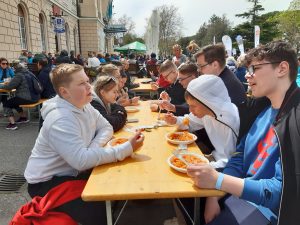
Am Nachmittag waren alle Gruppen angereist und trafen sich erstmals. Als Einstieg hatten wir einen kleinen Workshop zur Gebärdensprache, mit der wir schon im vorangegangenen Projekt begonnen hatten.
17.4., Montag
Den Montag begannen wir mit einem Fotoworkshop. Ob Kamera oder Smartphone, Einstellungen und Motivwahl, die Jugendlichen konnten sich in Theorie und Praxis in kleinen Arbeitsgruppen üben.
Einstellungen und Motivwahl, die Jugendlichen konnten sich in Theorie und Praxis in kleinen Arbeitsgruppen üben.
Nach dem Workshop besuchten wir in Gorizia das Kulturhaus. Hier wurden in einem Vortrag linguistische Traditionen in der Region und ihre heutige Verbreitung besprochen. Auf dem Weg dorthin sahen wir das Altstadtviertel Gorizias, darunter eine alte Synagoge im jüdischen Viertel.
18.4., Dienstag
Am Dienstag wurde das Tagesthema „Erster Weltrieg“ verfolgt. Dafür ging der Ausflug nach Kobarid und in das Kobariški muzej (Kobarider Museum), in dem wir auch eine Führung erhielten.
Der türkisfarbene Fluß Soča / Isonzo fließt durch das malerische Tal.
Hier fand die zwölfte und letzte Schlacht an der Soča/Isonzo 1917 statt, die „Schlacht von Caporetto/ Karfreit“, heute Kobarid. Tausende Menschen starben bei dem blutigen Stellungskrieg an der Isonzofront.
Die Kriegsgräuel spiegeln sich noch in der Kriegsgräberstätte Kostnica s Cerkvijo Sv. Antona. Sie wurde für die gefallenen Italiener errichtet.
Der wunderschönen Landschaft ist es nicht mehr anzusehen.

Im Museum wurde ein kleiner Workshop mit den Jugendlichen in gemischten Gruppen zu dem in Kobarid geschaffenen Erinnerungspfad veranstaltet. Welche Bedeutung könnten solche historischen Spuren und die Erinnerung an die historischen Ereignisse heute für uns haben?
19.4., Mittwoch

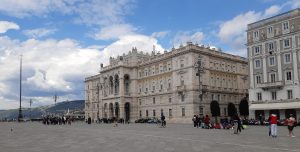
Am Mittwoch wurde das Kapitel zum Faschismus aufgeschlagen. Ein Tagesausflug nach Triest stand im Programm. In Triest wurde zunächst eine Stadtführung durch den italienischen Projektpartner (47/07) von Alex durchgeführt. Zentral war dabei das jüdische Leben in Triest durch die verschiedenen Zeiten hindurch. Die Stadtführung umfasste die Geschichte vom Imperium bis zum Zweiten Weltkrieg, begann am Hafen über den Piazza dell’ Unità d’Italia (Platz der Einheit), der Synagoge, die zu Beginn des 20. Jahrhunderts gebaut wurde und eine der bedeutendsten jüdischen Gotteshäuser in Europa war. 1942 wurde sie von den Faschisten geschlossen und nach dem Zweiten Weltkrieg wieder geöffnet. Der Rundgang streifte den Narodni Dom, der noch bis zum Ersten Weltkrieg Kulturzentrum der slowenischen Bevölkerung in der zu diesem Zeitpunkt zu Österreich-Ungarn gehörenden Stadt war. Heute wird das Gebäude von der Universität Triest genutzt. Weiter ging es zum Römischen Theater und dem Piazza Oberdan (Oberdan Platz), benannt nach Guglielmo Oberdan,

einem Anhänger der panitalienischen Bewegung, der mit einem Attentat auf Kaiser Franz Joseph 1882 bei seinem Besuch in Triest ein Zeichen gegen die Habsburger setzen wollte. Der Kaiser blieb dabei unverletzt, Oberdan wurde hingerichtet und zum Märtyrer gemacht. In einem der Gebäude am Piazza Oberdan befand sich nach der deutschen Besetzung das Gestapo-Hauptquartier mit Folterzellen und Gefängnis. Weitere Zentren der Gestapo waren über die Stadt verteilt.
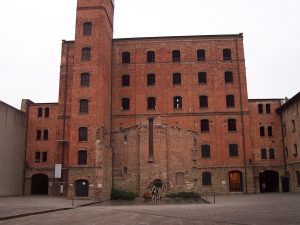
Abschließend besuchten wir das Rižarna -Civico Museo della Risiera di San Sabba Monumento Nazionale, das Nationale Denkmal und Museum der Reismühle von San Sabba, dem einzigen von Nationalsozialisten in Italien errichteten Konzentrationslager mit einem Krematorium. Bis zu 25.000 Menschen wurden dort gefangen gehalten, politische Häftlinge, Partisanen und Juden, die vor ihrer Deportation in die Vernichtungslager standen.
Die Anzahl der im Triester Lager ermordeten Häftlinge kann nur geschätzt werden und liegt zwischen 3000 und 5000 Toten.
20.4., Donnerstag
Das Tagesthema umfasste die Grenzziehung in der Goriška Region als Folge des Zweiten Weltkrieges. Aus einer Stadt wurden zwei: Nova Gorica und Gorizia.
Der Besuch von zwei Museen an der Grenze und über die Grenze (Museum Collection Kolodvor am Bahnhof von Nova Gorica / Museum Collection Pristava in den früheren Stationen an den Grenzkontrollübergängen in Pristava). Wir erhielten eine spannende Führung durch Gorizia und besuchten das italienische Museum Lasciapassare/ Przepustnica über die Geschichte der Grenze.
Am Nachmittag hatten wir noch die Gelegenheit in Nova Gorica einen Dokumentarfilm über den Schmuggel an der Grenze zwischen Nova Gorica und Gorizia zu sehen. Die Einwohner wurden nach Grenzfall befragt und haben sehr offen erzählt, wie sie es geschafft haben, beispielsweise Lebensmittel zu schmuggeln. Die Regisseurin Anja Medved war später beim Workshop und hat sich den Fragen der Jugendlichen gestellt.
Die AGs haben sich anschließend Gedanken zur Dokumentation dieser Begegnung und der Darstellung der neu gewonnen Eindrücke und historischen Erkenntnisse gemacht.
Am Abend gab es noch die einmalige Gelegenheit, eine Kulturveranstaltung der Schüler*innen des Gymnasiums in Nova Gorica zu sehen, die als Benefizveranstaltung für junge Student*innen gedacht war. Ein tolles Programm war zu sehen und hat die jungen Teilnehmenden unseres Begegnungsprojektes beeindruckt.
21.4., Freitag
Der Freitag startete mit einem kleinen Workshop zur Gebärdensprache. Alle Jugendlichen haben eine Strophe mit Refrain aus dem John Lennon Song „Imagine“ in Gebärdensprache erlernt und gemeinsam vorgetragen, ein Highlight dieser Begegnungswoche.
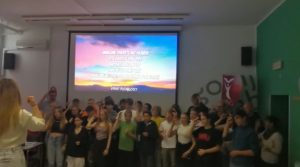
Dann folgte eine sehr interessante Stadtführung in Nova Gorica und eine wunderschöne Wanderung am Ufer des Flusses Soča/Isonzo
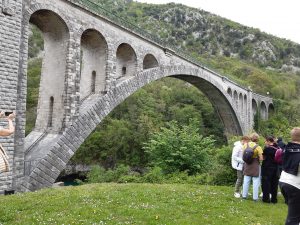
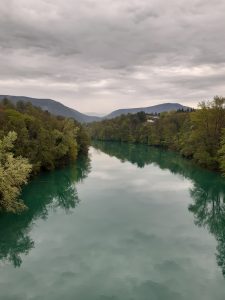
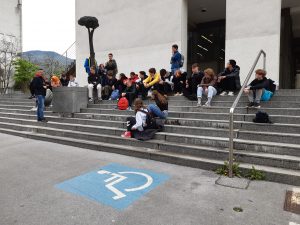
In den AGs wurden anschließend die Fotos gesammelt und ausgewählt, die für die Ausstellung in den Räumen von LUNG präsentiert werden sollten.
Am Abend haben die slowenischen Projektpartner eine Abschiedsfeier mit allen Projektteilnehmenden in unserem Hotel veranstaltet. Slowenische Projektteilnehmende aus dem vorangegangenen Projekt waren auch dabei, ein schöner Abend.
22.4., Samstag
Am letzten Projekttag wurde noch intensiv an den Dokumentationen gearbeitet. Mittags war es dann soweit. Alle Gruppen traten die Heimreise an.
Am Ende des Projektes ist eine kleine Foto-Ausstellung entstanden, die in den Räumen von LUNG zu sehen ist. Die Jugendbegegnung war ereignisreich und hat viele neue Eindrücke hinterlassen, die den jugendlichen Teilnehmenden noch lange in Erinnerung bleiben.
Wir freuen uns auf die nächste Begegnung!
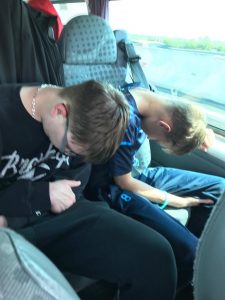
![]()
![]()
The follow-up project “Meja – Border” took place successfully for one week in spring 2023 as part of the series of projects “طخ / دودحلا – Border Line – Meja / Linje”. It was implemented within the framework of the “Erasmus+ / Youth in Action” program together with our European partners.
This time, the Slovenian partner LUNG – the People’s University of Nova Gorica – was the coordinator and organizer of the project and invited us to Nova Gorica/Gorizia.
Our partners:
• LUNG, People’s University in Nova Gorica
• Associazione Culturale Quarantasettezeroquattro in Gorizia
• Istituto Salesiano Bearzi, Udine
• MS 5 – Secondary School for Klagenfurt am Wörthersee–Wölfnitz
• Regionale Schule Sassnitz
A special thanks goes to Mojca (LUNG), who put together a very interesting program over the course of the week, Suzana (Gymnasium Nova Gorica), Marko (Goriški Muzej), and Alex (Associazione Culturale Quarantasettezeroquattro).
The Project
Following the previous project, this time young people from Slovenia, Italy, Germany, and Austria, boys and girls aged between 13 and 20, came together.
The aim was to make the division of regions and the process of overcoming division tangible at historical sites. The project explored the dissolution of Yugoslavia, the situation during the First World War, during and after the Second World War, and the division of the city in 1947 into a Slovenian Nova Gorica and an Italian Gorizia. It examined how the two cities developed separately yet side by side, divided by a fence, and how they evolved after the Schengen Agreement of 2007, since which the border between Slovenia and Italy can be crossed freely everywhere.
All participants are citizens of European Union member states, yet nationalism and prejudice remain challenges that must still be overcome. In 2025, Nova Gorica and Gorizia will jointly be European Capitals of Culture, alongside Chemnitz.
The young participants were encouraged to explore the different perspectives of local communities as well as those of the other project participants. The challenges of living together today could thus be considered in light of the experiences they had already gained in Berlin and Prora.
The Week of Exchange
After a long journey on April 15, we had the opportunity to take part right on Sunday in the “Walk of Friendship,” a wonderful 12 km walk through Nova Gorica and Gorizia. Fortunately, the group from Rügen had arrived early enough to join. The walk concluded with a well-deserved pasta meal.
In the afternoon, all groups had arrived and met for the first time. As an introduction, we held a small workshop on sign language, continuing the work we had begun in the previous project.


April 17 – Monday
We started Monday with a photography workshop. Whether using a camera or smartphone, the participants learned about settings and composition and practiced in small working groups, both theoretically and practically.
After the workshop, we visited the Cultural House in Gorizia, where a lecture introduced the linguistic traditions of the region and their current distribution. On the way there, we passed through Gorizia’s old town, including an old synagogue in the Jewish quarter.
April 18 – Tuesday
On Tuesday, the day’s topic was “The First World War.” The excursion took us to Kobarid and the Kobariški muzej (Kobarid Museum), where we were given a guided tour.
The turquoise Soča / Isonzo River flows through the picturesque valley.
It was here that the twelfth and final battle of the Soča/Isonzo took place in 1917 — the Battle of Caporetto/Karfreit, today’s Kobarid. Thousands of people died in the bloody trench warfare along the Isonzo Front.
The horrors of the war are still reflected at the Kostnica s Cerkvijo Sv. Antona war cemetery, built in memory of the fallen Italian soldiers.
The beautiful landscape shows no trace of the suffering that once occurred here.

At the museum, a small workshop was held with the young participants, working in mixed groups on the Kobarid Memorial Trail. They explored the question: What significance can such historical traces and the remembrance of past events hold for us today?
April 19 – Wednesday
Synagogue in Trieste – Government Palace at Piazza dell’Unità d’Italia
On Wednesday, the topic turned to Fascism. The day’s program included an excursion to Trieste. There, the Italian project partner Associazione Culturale Quarantasettezeroquattro (47/04), led by Alex, provided a city tour focusing on Jewish life in Trieste through different historical periods.
The tour covered the city’s history from the Austro-Hungarian Empire to the Second World War, beginning at the harbor, continuing to the Piazza dell’Unità d’Italia (Square of Unity), and then to the synagogue, built at the beginning of the 20th century — one of the most significant Jewish houses of worship in Europe. In 1942, it was closed by the Fascists and reopened after the war.
The tour also passed by the Narodni Dom, which until the First World War had been the cultural center of the Slovenian community in what was then part of the Austro-Hungarian Empire. Today, the building houses the University of Trieste. The route continued to the Roman Theater and Piazza Oberdan, named after Guglielmo Oberdan, a supporter of the pan-Italian movement who attempted to assassinate Emperor Franz Joseph during his visit to Trieste in 1882 as a protest against the Habsburg monarchy. The emperor was unharmed, Oberdan was executed, and later celebrated as a martyr.
After the German occupation, one of the buildings at Piazza Oberdan served as the Gestapo headquarters, containing torture cells and a prison. Other Gestapo centers were scattered throughout the city.
 Finally, we visited the Rižarna – Civico Museo della Risiera di San Sabba Monumento Nazionale, the National Memorial and Museum of the San Sabba Rice Mill, the only Nazi concentration camp in Italy equipped with a crematorium. Up to 25,000 people were imprisoned there — political prisoners, partisans, and Jews awaiting deportation to extermination camps.
Finally, we visited the Rižarna – Civico Museo della Risiera di San Sabba Monumento Nazionale, the National Memorial and Museum of the San Sabba Rice Mill, the only Nazi concentration camp in Italy equipped with a crematorium. Up to 25,000 people were imprisoned there — political prisoners, partisans, and Jews awaiting deportation to extermination camps.
The estimated number of prisoners murdered in the Trieste camp ranges between 3,000 and 5,000.
April 20 – Thursday
The day’s topic focused on the border demarcation in the Goriška region following the Second World War — when one city became two: Nova Gorica and Gorizia.
We visited two museums on and across the border: the Museum Collection Kolodvor at the Nova Gorica train station, and the Museum Collection Pristava, located in the former border control station at Pristava. We received an engaging guided tour through Gorizia and visited the Italian museum “Lasciapassare / Przepustnica,” which documents the history of the border.
In the afternoon, we had the opportunity to watch a documentary film in Nova Gorica about smuggling along the border between Nova Gorica and Gorizia. Local residents shared candid stories about how they managed to smuggle everyday goods, such as food, across the border. The director, Anja Medved, later joined our workshop and answered the participants’ questions.
The working groups (AGs) then discussed ways to document the encounter and present their newly gained impressions and historical insights.
In the evening, we attended a cultural performance by students from the Nova Gorica Gymnasium, held as a benefit event for young students. The program was excellent and left a strong impression on all participants of our youth exchange project.
April 21 – Friday
Friday began with a small sign language workshop. All participants learned and performed a verse and chorus of John Lennon’s “Imagine” in sign language — a true highlight of the week.
 Afterward, we enjoyed a guided tour of Nova Gorica followed by a beautiful hike along the banks of the Soča/Isonzo River.
Afterward, we enjoyed a guided tour of Nova Gorica followed by a beautiful hike along the banks of the Soča/Isonzo River.
In the working groups, the participants then selected and curated photographs for an exhibition to be shown in the LUNG premises.
In the evening, our Slovenian partners organized a farewell celebration at our hotel for all participants. Some Slovenian participants from the previous project also joined — a wonderful conclusion to an inspiring week.
April 22 – Saturday
On the final day, the participants worked intensively on their documentation projects.
By midday, it was time to depart, and all groups began their journey home.
At the end of the project, a small photo exhibition was created, now on display in the LUNG facilities.
The youth exchange was eventful and inspiring, leaving many lasting impressions that will stay with the young participants for a long time.
We look forward to the next exchange!


